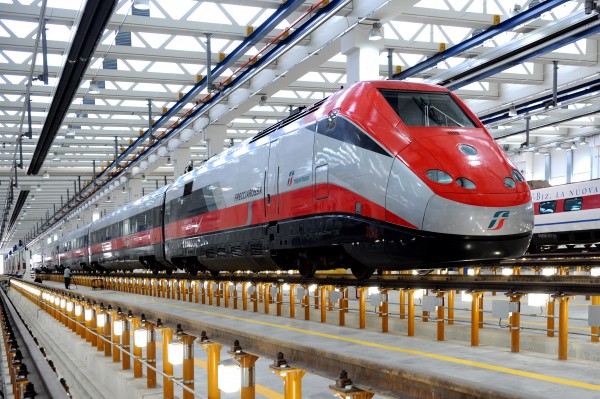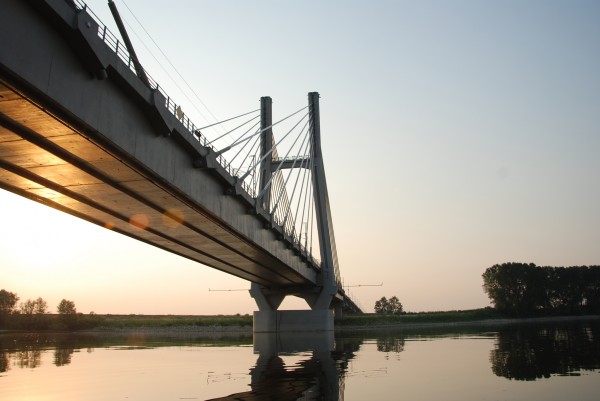High-speed in Italy and liberalisation
Posted: 3 August 2010 | | No comments yet
The FS Group (Italian State Railways) is the largest company in Italy, which has helped boost the Country’s growth, thanks also to the recent launch of the high-speed service. The Group has successfully completed a process of internal reorganisation that has turned it into a modern and efficient reality, up-to-date and ready for the challenge of rail transport liberalisation. A radical transformation was completed in less than three years through a financial turnaround combined with the start up of the high-speed service and fleet renewal. Let’s analyse the facts point-by-point.
The FS Group (Italian State Railways) is the largest company in Italy, which has helped boost the Country’s growth, thanks also to the recent launch of the high-speed service. The Group has successfully completed a process of internal reorganisation that has turned it into a modern and efficient reality, up-to-date and ready for the challenge of rail transport liberalisation. A radical transformation was completed in less than three years through a financial turnaround combined with the start up of the high-speed service and fleet renewal. Let’s analyse the facts point-by-point.
The FS Group (Italian State Railways) is the largest company in Italy, which has helped boost the Country’s growth, thanks also to the recent launch of the high-speed service. The Group has successfully completed a process of internal reorganisation that has turned it into a modern and efficient reality, up-to-date and ready for the challenge of rail transport liberalisation. A radical transformation was completed in less than three years through a financial turnaround combined with the start up of the high-speed service and fleet renewal. Let’s analyse the facts point-by-point. In 2009, with a net income of €44 million, the FS Group consolidated the financial turnaround which started at the end of 2006 with the introduction of a new management team, under Mr. Mauro Moretti, and who was recently reconfirmed at the helm of the Group. The Group had returned to profit in 2008, a year ahead of forecasts, with a net income of €16 million. The result for 2009 was achieved in a highly negative external context, affected by the global financial crisis which, particularly in freight transport, squeezed traffic volumes and hence revenue. But this was still a huge success, which is even more significant if compared with the financial performance of its major European competitors, which have seen their results slump severely. In any event, 2009 will take its place in Italy’s history as the year when the whole high-speed/high-capacity Turin–Milan–Rome–Naples–Salerno system was completed – a network that has revolutionised national transport. In fact, the ‘Italian highspeed metropolitan’ runs on 1,000km of dedicated track (out of a total network of more than 16,600km) that has allowed services to be specialised, taking the pressure off the existing line with benefits for the railway system in its entirety, including metropolitan, regional and freight traffic. Reaching the country’s most important urban centres and covering an area where 65% of mobility demand is concentrated, the high-speed service has tipped the balance back to rail transport, which is known to be the most environmentally friendly mode of transport. By changing mobility substantially between the major metropolitan centres, with more frequent scheduled connections, the high-speed service has, in fact, provided a boost to Italy’s social, economic and cultural life. With 70 trains per day between Rome and Milan, the high-speed service has won the challenge with the plane, attracting more than 50% of travellers moving between the two metropolises every day. The Frecciarossa fast trains (Rome–Milan without stopping) cover the distance between Rome Tiburtina and Milan Rogoredo in 2 hours 45 minutes and accompany the passenger right into the city centre. They also offer a number of extra services such as welcome drinks, free newspapers and high-quality catering.


A Frecciarossa in the ‘shop’ in Naples
The Italian high-speed service also owes its success to truly competitive travel times: 37 minutes to go from Bologna to Florence, crossing through the Apennines; 65 minutes between Bologna and Milan and an hour between Turin and Milan, the financial capital of the peninsula. All in complete relaxation, given the high level of comfort of the Frecciarossa trains: larger reclinable seats with more leg room and provided with courtesy lights, an audio socket and power for connecting a PC. At the same time, other fast links have also been inaugurated to the North-East, South and South-West with the Frecciargento trains that reach Venice, Verona, Bolzano, Bari and Lametia Terme. Thanks to Trenitalia’s various promotions, the luxury journey offered by the Italian high-speed service is now within everybody’s reach. And customer satisfaction is confirmed by the record number of Frecciarossa and Frecciargento tickets sold in the first six months of 2010: almost nine million, just for the Rome–Milan route, or 22% more than 2009, which had already recorded a monthly average of one million travellers. Growth on the Milan–Naples section actually reached 31%. Safety and punctuality are also improving constantly. In fact, new highperforming technologies, available as a result of investment in automation, have allowed continual progress in the safety field. As a result, there has been a constant fall in ‘typical’ accidents during the last two decades and, between 2006 and 2009, the accident rate fell by 63%. Punctuality and Customer Satisfaction are on the rise: 93.4% of passengers say they are happy with the high-speed service, whilst the appreciation figure rises to 95.3% for the ‘fast high-speed’ service. In March 2010, 82% of those interviewed judged punctuality performance to be positive – which was up 12% on January 2010. At the moment, the State Railways Group (Gruppo Ferrovie dello Stato) transports approximately 600 million people a year, of which a million and a half every month are on the high-speed service alone and is also working on developing new nigh-speed stations at Turin Porta Susa, Bologna, Florence, Rome Tiburtina and Naples Afragola. With a view to raising quality standards even further, FS has launched an international tender worth more than €1.2 billion for the supply of 50 new design high-speed trains, which has triggered interest from the most important constructors throughout the world. The competitors have been asked to run the train at a speed of 360km/h, ensuring transmission of the same forces and acceleration that take place at 300km/h. “Our train will be the train of the future, the finest and most modern on the market, with exceptional characteristics, capable of outclassing even the ultra high-tech Japanese trains, which are the best at the moment, six years ahead of everyone else,” stated Mr. Moretti. “The new high-speed train will be able to exceed 400km/h and will travel on our network at 360km/h.” In fact, in view of the liberalisation of the rail system, with the new super-train, FS aims not only to renew the Italian fleet in order to contend with future internal competition, but also to face European competition. And in anticipation of the opening of frontiers, the FS Group has also on several occasions expressed an interest in remunerative market services outside Italy as well. And it is for this reason that the Ferrovie dello Stato has even more challenging objectives ahead: on the assumption that there is an underlying system of rules that are certain and equal for everyone, the FS Group is ready to grow in national and international terms, contributing with its experience and infrastructures and accepting the challenge of competition that is no longer just national but is already continental.


The cable-bridge over the Po River on the Milan–Bologne line
As Chairman of the CER (Community of European Railways), Mr. Moretti has, in fact, highlighted the difficulties of creating a truly free railway market in Europe. The countries are liberalised differently and reciprocity is a rule that is not always applied by everyone. “Public Service Obligations should be completely separated from commercial services in the accounts of the rail companies,” stated Mr. Moretti during the 10th meeting of the CEOs of European rail companies. “This would avoid both imbalances between the amounts paid by individual countries for Public Obligations and disparities of financial capacity between the different companies.” To sum up, the Italian high-speed service has come to represent a major turning point for the country which it is not an exaggerated statement – Italy has not seen such a decisive change since the end of the Second World War. The contribution in terms of environmental impact is also enormous. In fact, with the activation of the Turin–Salerno high-speed service, the average increase in travellers in 2009 was approximately 25% compared to 2008, and between Rome and Milan the train market share rose from 36% to 50%. Percentages that, when converted into ecosustainability, are the equivalent of a saving of more than 30,000 tonnes of CO2, in 2009 alone. In fact, on the Milan–Rome route, the Frecciarossa trains produce on average 72% less CO2 than planes and 60% less than cars. It was on 2 July 2010 in Brussels, that Mr. Moretti, when discussing the subject of energy saving in the rail field at the European Business Summit (organised yearly by Business Europe the European Employers Federation), pointed out that eco-sustainability has always been part of the policy of the Ferrovie dello Stato and that the Group is highly committed to the energy ‘decarbonisation’ policy. In fact, the train is the most environmentally friendly means of transport, particularly when compared to flying. In addition, Mr. Moretti also pointed out that, in the last 20 years, more than 1,600km of lines were converted from diesel to electric, thereby confirming that, thanks to the FS policy, Italy is today one of the most developed countries in Europe in terms of network electrification. It is precisely due to electricity that the train is the only means of motorised transport that can reduce dependence on fossil fuel to a minimum. For this reason, within a framework of sustainable development, more than 30% of energy used by the FS Group today comes from renewable sources. And the use of photovoltaic cells has provided a further impetus to full independence from fossil fuel energy. Mr. Moretti has illustrated how these objectives, aimed at eco-sustainability, also touch on the design of rail infrastructure, through a rational use of resources and environmental protection approach. On that occasion, Mr. Moretti has also mentioned the so-called ‘Green Ticket’ recently introduced to inform passengers on the level (expressed in kilos) of CO2 savings for their train journey compared to plane or car travel. The CO2 emissions avoided are converted into ‘Green Points’ so that each passenger can store and use to get either free train tickets or giveaways by Trenitalia. With such an initiative, not inexpensive for the company, FS wants to contribute to a general process of cultural and behavioural change towards higher environmental awareness and a low carbon economy.
About the Author
Mauro Moretti
Mauro Moretti has been the CEO of the Ferrovie dello Stato Group since September 2006, and became Chairman of CER (Community of European Railway and Infrastructure Companies) in January 2009 and is also the Vice President of UIC (Union International des Chemins de Fer) and Vice President of the European Management Committee of UIC. Since 2004, Mr. Moretti has also been President of CIFI (Italian Association of Railway Engineers). At the end of May 2010, Mr. Moretti was awarded ‘Cavaliere del lavoro’ by the Italian President, Giorgio Napolitano. Mr. Moretti’s career began with a degree in Electro-Technical Engineering from Bologna University in 1977 and, in the same year, he won a public competition for an executive position at the Azienda Autonoma Ferrovie dello Stato. He was only 24.







